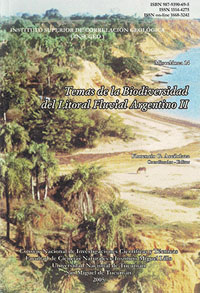Miscelánea 14
Determinación de unidades homogéneas de vegetación en el Parque Nacional Pre-Delta (Argentina)
Pablo G. Aceñolaza | Walter F. Sione | Fabio A. Kalesnik | M. Cristina Serafini
Descargar trabajo en formato PDFAbstract
DETERMINATION OF VEGETATION HOMOGENEOUS UNITS IN THE PRE-DELTA NATIONAL PARK, ARGENTINA.-Land coverage and vegetation distribution shows land use history and variation on environmental conditions. Remote sensing has demonstrate been an efficient tool for vegetation cartography in a regional scale. The main objective of this study is to evaluate the result of a classification on a natural area using a new tool, the segmentation technique. Landsat T ETM+ of 14 of July 2001 was use to generate coverage cartography of the Pre-Delta National Park. This Park corresponds to a group of islands placed in the Paraná River floodplain at 32º of latitude south. 7 units were classified, 5 of them correspond to vegetation: (U1) Mixed Cliff Forest; (U2) Simple floodplain forest; (U3) Mixed floodplain forest; (U4) Intermediate environments vegetation; (U5) lagoon vegetation. Units 1 and some old forest of Unit 3 have higher values of richness and diversity. U5 presents a assemblage of communities linked to ponds and open lagoons, including floating and rooted vegetation. U4 is the unit with more difficulty to circumscribe as it present mainly herbaceous/shrubby communities developed in a gradient from close to the ponds and limiting with forest in the higher parts of those islands. A highly accurate differentiation between plant communities in this area was not possible using imaginery, but an improved classification was obtain in contrast with those based in spectral characteristics only. This was due to the existence of tools that allow shape, size and other patterns, to be added the spectral classification.






